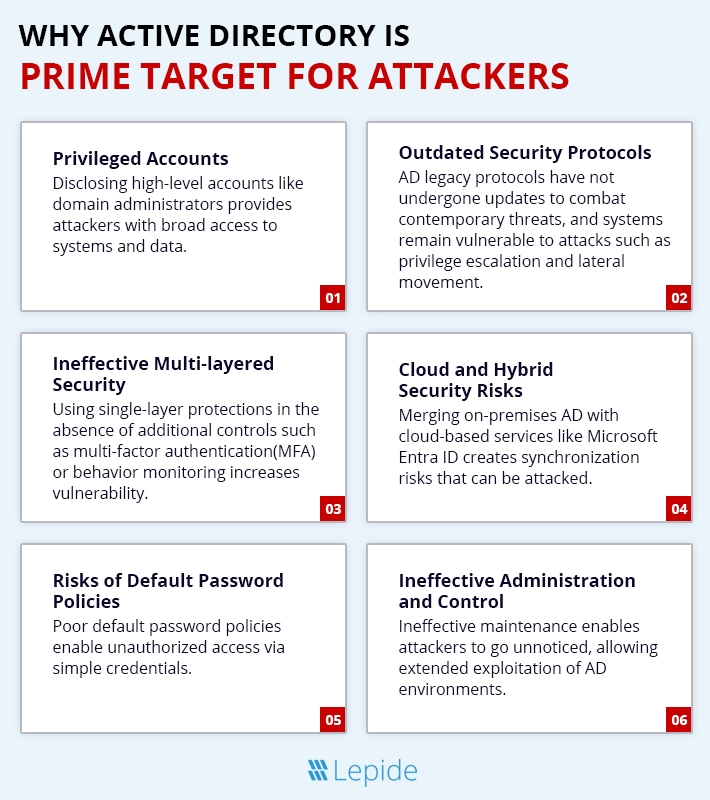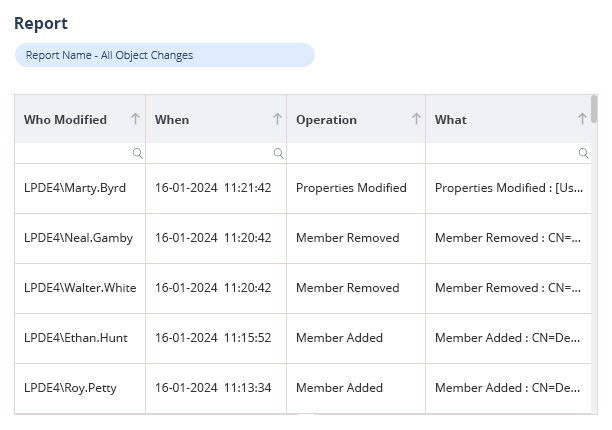
Active Directory is a vital part of corporate IT infrastructure because it controls network access and authenticates users. It’s no surprise then that Active Directory is the focus of attackers. Let’s explore some of the primary reasons why attackers love focusing on your AD.
Why Active Directory is a Prime Target?
For more than 25 years, Microsoft Active Directory has been the identity management backbone of companies important to networks, and it has remained a top target for attackers for just as long. Here’s why:

- Privileged Accounts: One of the major reasons for attacks is the existence of extremely privileged accounts in Active Directory, like domain administrators, who have wide control over data and systems. An attacker can easily move to higher-level access and control the whole network if just one of these accounts is breached. This privilege facilitates switching between various computers, stealing sensitive information, and launching other attacks such as ransomware distribution relatively easier. There are serious security vulnerabilities in Active Directory because most organizations are deceived into thinking it is secure out of the box.
- Outdated Security Protocols: That Active Directory’s (AD) fundamental security protocols have remained without major improvement over the years is one of AD’s central issues. Though AD remains a crucial part of organizational infrastructure, all of its essential protocols-designed many decades ago haven’t significantly improved to accommodate today’s cyberattack threats. Because of security vulnerabilities in these old protocols, AD is susceptible to attacks such as lateral movement, privilege escalation, and unauthorized access. Moreover, even if AD would enhance security, organizations might not want to replace or overhaul these old protocols because they are usually deeply embedded in current systems. Since major security defenses cannot be constantly fortified, attackers can utilize known weaknesses in AD to access systems, harvest sensitive information, and gain persistence in the network.
- Ineffective Multilayered Security: Insufficiency of multilayered security, where multiple defense methods are implemented at various levels to defend against numerous attacks, is one of the biggest issues for most companies. Dependence on a single security control, for instance, firewalls or antivirus programs, at times leaves networks vulnerable to more subtle attacks. In the absence of additional security controls such as behaviour monitoring, multi-factor authentication (MFA), or more advanced endpoint protection, attackers have an easy time gaining access and privilege elevation. In the absence of these crucial defenses, organisations are very exposed to breaches that could otherwise have been prevented.
- Cloud and Hybrid Security Risks: As more enterprises leverage cloud-based Microsoft Entra ID and on-premises Active Directory (AD), the use of hybrid environments is on the rise more than ever. Few companies are concerned with security considerations such as password strength despite syncing user identities on different systems for ease. By doing so, it gets easier for an attacker to pick up vulnerabilities with an easier exploitation for both the on-premises and the cloud environments.
- Risks of Default Password Policies: The majority of companies use default password policies that are weak and inadequate for safeguarding sensitive systems such as Active Directory. The default options may allow for easy-to-guess passwords, weak complexity, or long password reset timeouts, making it easy for attackers to gain unauthorized access. For enhanced security, organizations must adjust their password policies to encompass tougher requirements such as complexity requirements and regular password upgrades.
- Ineffective Administration and Control: The other factor is that most companies’ Active Directory environments and monitoring are not effective. This provides the attackers with the luxury of remaining undetected for months. They will be able to conduct privilege escalation and lateral movement operations due to this tactic. Ineffective AD event monitoring can cause situations where security vulnerabilities or problems are discovered and fixed too late.
What are the Common Attack Methods in Active Directory?
- Kerberoasting: A post-compromise attack, which takes place after a hacker has previously penetrated a system. The attacker looks through memory for a certain group of accounts that use Kerberos authentication, also known as service accounts. Accounts that contain a password hash and a jumbled form of the password are asked to submit a specific ticket.
- Pass-the-hash-Attacks: The second type of attack is called a “pass-the-hash attack,” in which the hackers take a hashed password instead of the original. The attacker utilizes the hash and re-uses it to obtain access as the user instead of needing the original password.
- Gold-Ticket Attack: A powerful Kerberos attack known as the “Gold-Ticket Attack” enables hackers to take over a whole domain (network). A falsified Kerberos “ticket-granting ticket” (TGT), which is used to establish identification in a network, is created by the attacker. They can use this fake ticket to access anything and pretend to be anyone in the domain, including domain administrators.
- Silver-Ticket-Attack: A more focused Kerberos attack than the Golden Ticket is the Silver-Ticket Attack. A fictitious “service ticket” is created by the attacker for a specific service (such a web server or file share). Use faked credentials to gain access to a certain service without going via the domain controller.
- DC Shadow Attack: An inconspicuous method of altering Active Directory (AD) is the DC Shadow Attack. By creating a shadow domain controller, the attacker can force unauthorized changes into AD, including giving himself administrator rights. It makes permanent adjustments to AD that aid them in remaining undiscovered and in command.
In the last two years, 40% of Active Directory attacks were successful, impacting 50% of companies, as the adversary exploited poor Active Directory hygiene.
How to Mitigate Active Directory Security Risks?
- Proactive Security Measures: Organizations should employ a well-balanced combination of proactive and reactive security measures because advanced threats are increasingly targeting AD. AD’s security posture can be significantly improved by implementing the recommended best practices.
- Implement Robust Authentication Procedures: Passwords are no longer sufficient, especially for accounts with more access levels. Use multi-factor authentication (MFA) for all users, particularly for sensitive and privileged accounts, to increase security and prevent unwanted access.
- Least Privilege Principle (PoLP): The Least Privilege Principle (PoLP) states that administrators and users should only have access that is necessary for their respective roles. Review and revoke permissions on a regular basis to prevent privilege creep. Never use a privileged account as your default login for routine tasks; instead, use it only when absolutely required.
- Early Detection Brute Force Attacks: In one instance, an organization observed a typical rise in unsuccessful attempts to log in to multiple accounts. They found and blacklisted the problematic IP address using AD monitoring. The attacker tried to guess passwords in a methodical manner in this brute force attack. The hazards can be reduced, and the threat can be swiftly contained with the help of active monitoring.
- Segmenting Critical AD Components: Segmenting the network will allow you to separate important AD components, such domain controllers, from the rest of the system. If the attacker gains partial access, this will limit their movement. Use access control lists (ACLs) and firewalls to limit communication with these systems.
- Monitor and Audit AD Activity: To find unusual or dangerous activities, such as attempts at privilege escalation or unauthorized object modifications, do routine audits and monitoring of AD. Use advanced Active Directory auditing tools that provide information on AD activity and help spot patterns or irregularities that might indicate a compromise.
- Strong AD Disaster Recovery Plan: Create and maintain a robust AD disaster recovery system. Backups must be stored off the main network and offline. Maintaining validated and reliable backups helps to minimize downtime and data loss in the event of a breach and speed up recovery.
- Strengthen Password Practices: Require strong passwords and change your login information frequently. Avoid using weak or default passwords, especially in situations when access is more extensive. To reduce risk exposure, disposable accounts must meet strict establishment and termination requirements.
- Disable Vulnerable Legacy Protocols: Turn off outdated and unsafe authentication methods that are known to be susceptible, such as NTLM. Use more secure options, such as Kerberos, instead. To adhere to current compliance standards and best practices, review security settings on a regular basis.
- Utilize Endpoint Detection and Response (EDR): To identify and protect endpoints connected to AD, such as workstations and servers, use EDR solutions. EDR tools can respond to suspicious logon attempts directed at the AD environment, detect and interrupt malicious activities, and stop malware infection.
- Regular Security Assessments: To find vulnerabilities or misconfigurations in AD, conduct regular security assessments using techniques like vulnerability scans and penetration testing. To strengthen the AD security environment, any issues that arise during these tests must be fixed.
How Does Lepide Help?
Lepide Active Directory auditing solution assists organizations in tracking, monitoring, and reporting on every change made to their AD environment in real time. By providing a detailed audit trail of user activity, group policy modifications, permission modifications, and so on, Lepide enhances security and compliance efforts. Automated alerts and pre-configured reports help IT teams to detect suspicious activity, unauthorized access attempts, and privilege escalations before they become security incidents.
By enhancing visibility into Active Directory activity, Lepide’s auditing tool enhances IT governance and allows organizations to secure their critical systems proactively.
Curious why attackers are drawn to Active Directory? Schedule a demo with one of our engineers or download a Free Trial to get started.



